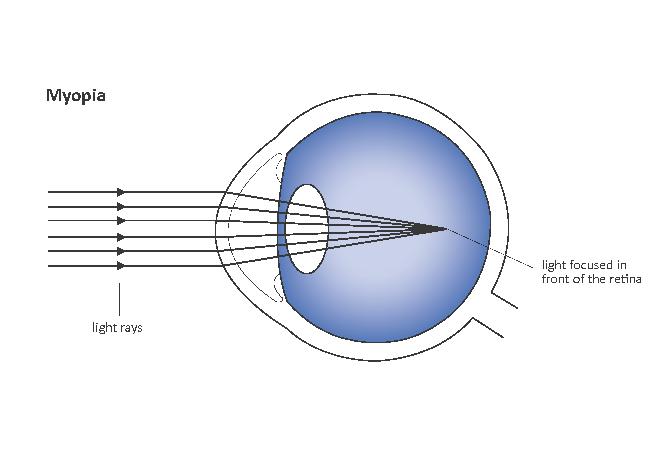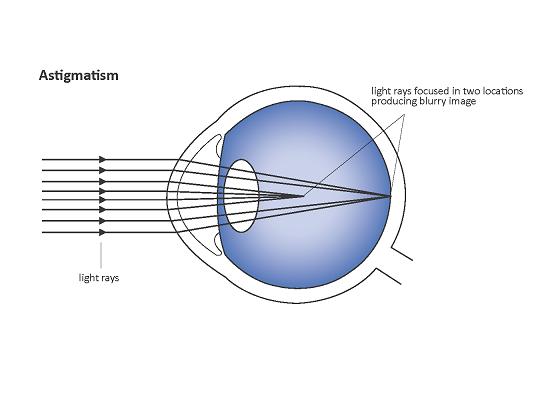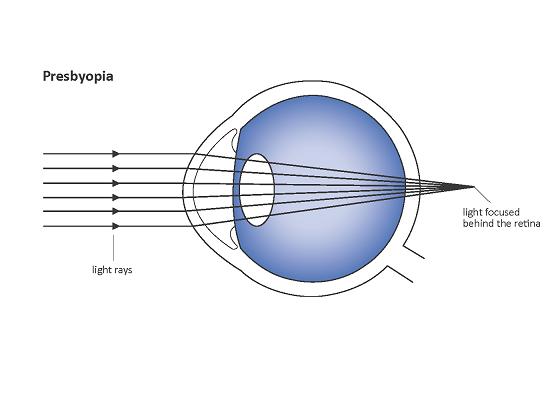Types of Refractive Error and Presbyopia
Types of Refractive Error
If an eye requires glasses or contact lenses in order to focus properly, it is said to have a “refractive error.” There are four main types of refractive error that affect the eye: myopia, hyperopia, astigmatism and presbyopia. Each of these refractive errors can be treated with glasses or contact lenses, and one or more can affect a single eye.
Myopia
This refractive error occurs when light is focused in front of the retina. Patients who have myopia are said to be nearsighted. This is because nearsighted patients can clearly see objects that are placed close, or near, to the eye. Lenses that correct for myopia, shift the point at which light is focused further back in the eye so that it falls on the retina.
Illustration of myopia, or nearsightedness, where light rays are focused in front of the retina causing images in the distance to be blurry.
Picture simulating vision in a myopic eye, where objects at near are in focus, but objects in the distance are blurry.
Hyperopia
This refractive error occurs when light is focused at a theoretical point behind the retina. Patients with this type of refractive error are said to be farsighted. This is because these patients can usually see in the distance without difficulty if their hyperopic refractive error is not too great. These patients, however, have difficulty seeing clearly up close.
Illustration of hyperopia, or farsightedness, where light rays are focused behind the retina causing images at near to be blurry.
Picture simulating vision in a hyperopic eye, where objects in the distance are clear, but objects at near are blurry.
Astigmatism
Astigmatism is typically caused by a differential curvature of the cornea vertically and horizontally. It can also be caused by abnormalities in the lens, and this form of astigmatism is called lenticular astigmatism. Patients who suffer from an astigmatism have blurry vision both at distance and near. This is because light never becomes perfectly focused at any point. These patients tend to be more symptomatic than those with simple hyperopia or myopia, because there is no point at which their eyes focus correctly without the assistance of glasses or contact lenses.
Illustration of astigmatism showing that light rays are never properly focused causing images to be blurry at all distances.
Picture simulating vision in an eye with astigmatism, where objects at near and in the distance are blurry.
Presbyopia
Most individuals over the age of 40 are familiar with presbyopia; this is the refractive error that develops as we age. It results from a process called “loss of accommodation,” which occurs as the lens in the eye ages. Accommodation is the process that allows the eye to focus from distance to near, and at each point in between. If you are reading this website, you may be familiar with the changes occurring in your vision as you get older. In particular, we have to hold objects further and further from our eyes in order to focus. The lens in the eye controls the distance at which we can focus by altering its shape, and as it ages, becomes stiffer and less flexible. As the lens becomes less flexible, it loses its ability to change shape. This results in a narrowed “range of focus.” Eventually, we need glasses, commonly referred to as reading glasses, in order to see things up close. If you already wear glasses when presbyopia sets in, you will need a traditional bifocal or no-line bifocal (a progressive lens).
Illustration of presbyopia, where light rays are focused behind the retina causing images at near to be blurry.
Picture simulating vision in a presbyopic eye, where near vision clarity decreases with age due to decreased flexibility of the crystalline lens.
© Vision Information Services, LLC, Mooresville, NC 2012







